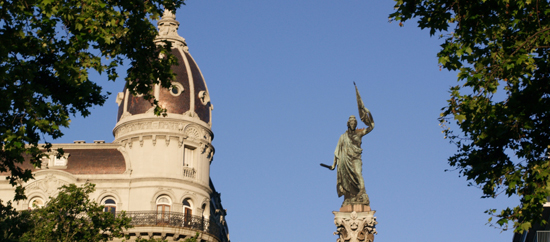
City Sounds: Montevideo
20 May, 2010In many ways Montevideo is seen as synonymous with Buenos Aires. They are both capital cities of countries that lay claim to being the originators of Tango (Carlos Gardel, the master of Tango, was born in Uruguay yet grew up in Buenos Aires.) Music coming from these cities is generally known as Rioplatense, due to the river that seperates them, but this all-encompassing nom de plume can be somewhat misleading as Montevideo has managed to carve itself out a very distinctive identity. Drums play a leading role as the calling card of the streets, Spanish influence has lad to a unique style of theatre and the man who mixed all of these things together with a touch of Brazilian flair stands as their main musical icon.
Drumming in the streets – the world of candombe
Montevideo is as intertwined with candombe as Rio is with samba. Every neighbourhood has their own comparsa (drumming group) which parades their local streets every week. It’s a ritualistic, poweful tradition that has passed through generations of European descendents ever since they first learnt the style from African slaves in the mid-nineteenth century. Groups differentiate themselves through their dances, costumes and, of course, the quality of their drumming, much the same way as the samba schools do for Rio’s carnival. Candombe is a very strong, insistent style of drumming, far less flashy than samba. Generally the ability for a group to hold such an insistent beat for parades that can last for hours would be seen as the height of a group’s abilities. However, more African and female groups have started in recent years to offer more rhythmic and stylistic variations, and perceptions may be beginning to change.
Best time to see candombe is Dia de los Reyes on January 6th when all the candombe groups are in full costume but there is a casualness in the air. It is possible to walk with the comparsas, something that doesn’t happen during the carnival parades (normally occurring on the first week in February) where the audience is behind rails.
Theatre, song and comedy collide – let’s call it Murga
Murga is a style of musical theatre performed during Carnival. Normally featuring a chorus and three percussionists (wearing slightly ridiculous costumes, for comic effect), performances are themed with songs interspersed with dialogue and jokes. It’s a style of theatre very much for the working classes. Songs will feature melodies from old folk songs and make fun of unpopular politicians (Uruguayans are very politically-aware) or former presidents, as well as poke a few jabs at foreigners and unpopular neighbours (i.e., Argentina.) Don’t worry though, it is all in good fun!
During Carnival murga is everywhere, with performances on specially-erected street stages, social and sports clubs and in all the theatres. Best of all, it is very cheap, and although non-Spanish speakers may not be able to understand all the jokes, it’s a great way to see how the Montevideans like to amuse themselves.
Eduardo Mateo sets the template for Uruguayn pop
In the late 60s Uruguay was caught by the British pop invasion as much as the rest of the world. The Shakers were almost identical to the Beatles in every way; their style, their music and even their album concepts (The Secret Conference at Toto’s Bar was in every way their Sgt. Pepper’s). Developing at the same time was El Kinto, a band with the same energy yet defiantly Uruguayan. They took the rock band format yet added candombe drumming, bossa nova style guitar and one of the most melancholy voices around. This was the voice of Eduardo Mateo. After recording one album the group split and Mateo ended up going solo. His first solo album, Mateo Solo Bien se Lame, featuring just him and a candombe drummer is near perfection. His albums would became more sombre and more folk-orientated though he always kept the dual influences of candombe in the rhythms and bossa nova for his guitar style. The style would become known as Candombe Beat, and would feature heavily in Uruguayan pop music with musicians such as Jaime Roos adopting the style in later years.
Follow Sounds and Colours: Facebook / Twitter / Instagram / Mixcloud / Soundcloud / Bandcamp
Subscribe to the Sounds and Colours Newsletter for regular updates, news and competitions bringing the best of Latin American culture direct to your Inbox.

